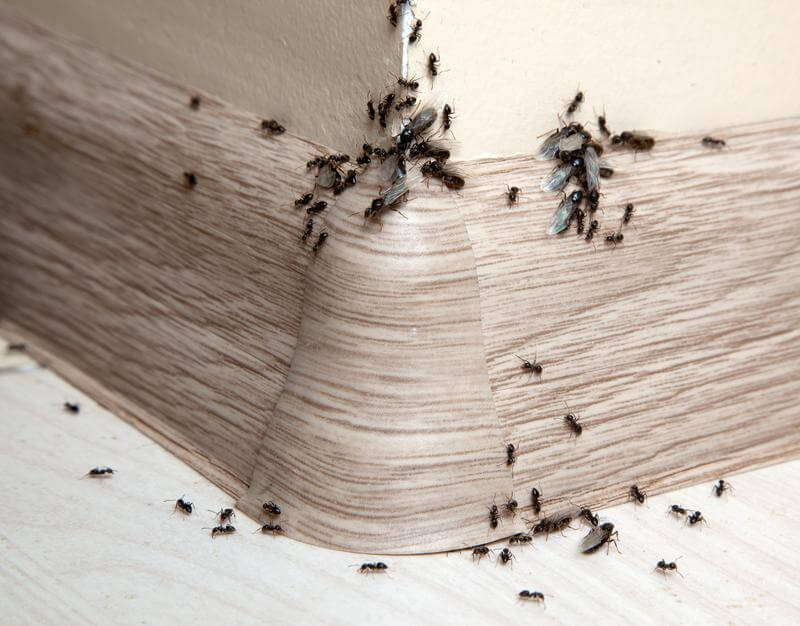Updated April 27, 2025

Ants are tiny troublemakers that love making themselves at home where they don’t belong. And when they do, it’s rarely just a couple of stragglers. If you’re spotting ants indoors, it’s time to pay attention.
Ant infestations can creep up on you fast, especially when these pests find the perfect conditions to set up shop. So, what are the most obvious signs of ants, and how can you stop them from turning your house into their hangout? Let’s break it down.
Signs of an Ant Problem
If ants are roaming around your home like they pay rent, you’re dealing with more than a stray scout or two. Here’s how to spot an ant infestation before it spirals out of control.
Presence of Ants
It sounds obvious, but if you’re spotting ants indoors, that’s your first clue. A couple of ants here and there doesn’t always mean trouble, but if you’re seeing trails of ants or large clusters gathering around food sources, it’s a surefire sign of an ant problem.
Ants often leave behind pheromone trails, signaling to their colony mates the location of a food source or a potential nesting site. If you notice ants marching purposefully toward your home or congregating around entry points, it’s a sign of an organized invasion that demands attention.
Sawdust Trails.
Carpenter ants aren’t shy about leaving clues behind. Unlike termites that devour wood, these ants dig through it to build their nests, leaving behind little piles of sawdust-like frass and wood shavings. It’s one of the most blatant signs of ants setting up shop in your home, especially when they’re tunneling through your walls or furniture.
Indoors or outdoors, keep a keen eye out for these sawdust trails near wooden beams, flooring, or furniture. Inspect wooden surfaces for these small piles of sawdust, and pay close attention to spots where wood meets potential entry points like window ledges, door frames, or utility openings.
Carpenter ants are particularly drawn to damp or decaying wood, making areas prone to moisture, like basements, attics, and crawl spaces, other prime targets for infestation.
Be mindful of any changes in the texture or appearance of wooden structures around your home. Carpenter ant infestations can weaken the integrity of wood over time, resulting in sagging floors, hollow-sounding beams, or visible damage.
Hollow Sounds
Tap-tap-tap. Hear something hollow? If you’re knocking on wooden surfaces and getting a strange, empty sound back, you could be dealing with carpenter ants. Their relentless tunneling weakens the wood, leaving it brittle and far more vulnerable to damage than you might think.
Be thorough in examining wooden surfaces, tapping along beams, floors, and walls to identify any hollow-sounding areas. Take note of any changes in pitch or resonance, as these may indicate areas of significant ant activity.
Structural Damage
When ants are left to do their thing, you’ll eventually see the damage. Sagging floors, warped doors, cracks in wooden beams, these are all signs of a carpenter ant problem that’s gone from a minor nuisance to major headache.
Carpenter ants can absolutely wreck your home’s structural integrity. If you’re noticing damage that seems out of nowhere, it’s time to get serious about addressing the ant infestation before things get worse.
Piles of Soil
Ant nests vary in size and shape, ranging from small mounds to extensive underground networks. They serve as the central hub of ant activity, housing the colony members and breeding grounds for new generations.
Inspect your lawn for these soil piles; however, if you notice signs of ants, avoid disturbing the nest. Take note of the mound’s location, size, and shape, as well as any visible ant trails leading to or from the nest.
Ants love moist soil and shaded spots, so you’re more likely to find their nests tucked away in areas with plenty of moisture or near food sources. Inspect flower beds, backyards, and even the edges of patios.
Discarded Wings
What causes flying ants in your house in the summer? Why exactly do you have ants in your home anyway?
During the summer months, ants undergo a “nuptial flight,” during which winged reproductive individuals, known as alates, leave the nest searching for mates and suitable locations to establish new colonies.
After mating, the males typically die, while the fertilized females shed their wings and seek out nesting sites to begin new colonies. Finding discarded wings in and around your home are clear signs of an ant problem and their nuptial flight.
Audible Rustling
As ants forage for food, expand their colonies, or seek new nesting sites in your home, they may produce rustling sounds as they move through these confined spaces.
To hear these rustling noises, take a moment to listen closely to your walls, floors, or any area where you suspect ants reside. Focus on quiet moments, such as late at night or early in the morning, when ambient noise levels are minimal.
Preventing Ant Infestations with Natura
Taking proactive measures is vital to minimizing the risk of ant infestations in your home. By implementing the following strategies, you can create an environment that is less hospitable to ants and reduce the likelihood of them setting up camp in your home:
- Properly Dispose of Food Waste: Dispose of food scraps and keep leftovers in tightly sealed containers. Regularly empty your trash to prevent odors and food residue that may attract ants.
- Clean-up Spills: Spilled food and beverages can entice ants to invade. Promptly clean spills to remove a potential ant food source.
- Wash Dirty Dishes and Utensils: Dirty dishes left in the sink can attract ants looking for food residue; wash them soon after use to remove lingering food particles.
- Seal Gaps and Cracks: Seal gaps around windows, doors, and other entry points with weatherstripping or caulk to prevent ants from gaining access to your home.
- Elevate Firewood: Keep firewood stored off the ground and away from the exterior walls of your home to reduce the likelihood of ants nesting in the woodpile and migrating into your home.
- Prune Dead Trees and Bushes: Dead or decaying tree limbs can serve as prime nesting sites for ants. To minimize the risk of ant infestations, regularly prune trees and bushes and remove dead limbs on your lawn.
But what are your best options for long-lasting treatment against an ant infestation in your house or property? The experts here at Natura.
Spotting the signs of an ant problem isn’t always easy, but our trained technicians can quickly locate and eliminate these pests. When you’re struggling with house ant problems, give us a call!



